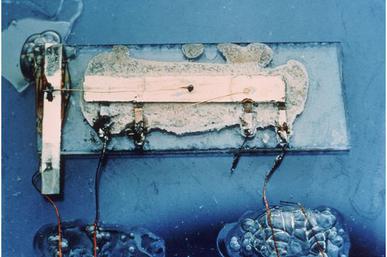I have finally got a complete design for a biological integrated circuit. I can characterize the gate delay, rise time, amplification and power consumption. The image is the first mechanical integrated circuit using electron cascade for logic courtesy of Wikipedia. I can reasonably produce a biological device which would operate at 1 megahertz and perform the function of memory, ALU and actually any model based on the concept of NAND. 1 MHZ is hardly competitive though it is faster the first 8-bit cpus.
The real value comes from the fact that it can be manufactured from common biological materials without any expensive equipment. It allows the remote assembly of a computer by biological methods from a seed like structure. It would be useful at 1 MHZ and low data widths, but this is the prototypical device and a very rough design. There is a clear migration path for manufacturing that would allow gate delays on the order of 10-13 as a lower limit. That is certainly not a massive gain compared to the existing circuits which AFAIK now can operate in the tera-hertz (1012/sec) range. The ultimate advantage is manufacturing cost, power consumption and complexity per volume. The energy requirements of a transistor switch lead to complications when the heat per calculation is considered. By using a well controlled biological transition that has been devised over a period of billions of years, the waste kinetic energy is minimal. It allows the density of circuit to reach down to the 30 A° level and thus it is theoretically possible to have densities in the 1027 bio-transistors per cubic meter without over heating. In some ways the temperature would increase the gate transition time and would be self limited so that it would not suffer thermal run-away that is possible with some materials. Since the operation is thermally limited it would not be able to clock consistently above a certain speed without going into a thermal oscillation about its energy density limit.
The combination of biologically constructed mechanical operators and a convenient means to transfer the technology of existing computer programs to a biological brain of sorts, would allow the communication of a data sequence in terms of seed biological sequence like DNA to produce an "organism" like bot at a remote location which was capable of translating the message to biological materials. It would require the presence of the dependent atomic molecules, and could build and decompose based on a carried volume of appropriate biologics. Something like "chicken and egg" forever.
I personally favor new CPU and ALU designs, however it is appropriate to emulate the language of X86 or ARM or some other cpu which is out of patent or copyright and can be used as a target for a C compile.
The remaining complexity and advantage could be leveraged to have mega-terabytes of cache like memory. The material is such that it can also be easily interfaced to an electronic circuit on some conversion like device such as USB. Given that much of the technology for scale reduction already exists it is not a Gordon Moore curve to the complex design, but more like a catalytic reaction.
The greatest advantage of the circuit might be the fact that it can be powered by sunlight and thus is complete unto itself without the trappings of technology that make mechanical designs improper for space based systems due to cost. It should be obvious that in order to achieve computations at the 1013*1027 operations per second it would require a rather large surface area exposed to a radiation source. 1040 ops is above the threshold of simulating the human brain.
Another distinct advantage is that the design can be ported through the internet very easily and this side steps the obvious problem that such a design would completely collapse the technology sector that centers around silicon based circuit of all types.



0 comments:
Post a Comment